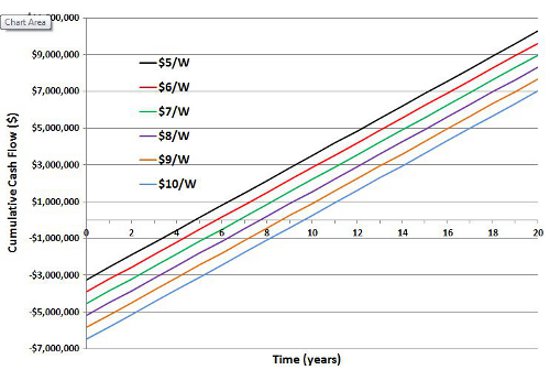(Created page with "{{QASpage}} ===Citation=== Dirk V. P. McLaughlin, Nicole C. McDonald, Ha T. Nguyen and J. M. Pearce, [http://ccsenet.org/journal/index.php/jsd/article/view/6499 “Leveraging P...") |
mNo edit summary |
||
| Line 3: | Line 3: | ||
===Citation=== | ===Citation=== | ||
Dirk V. P. McLaughlin | Dirk V. P. McLaughlin and J.M. Pearce, [http://dx.doi.org/10.1016/j.mseb.2011.12.008 “Analytical Model for the Optical Functions of Indium Gallium Nitride with Application to Thin Film Solar Photovoltaic Cells”], Materials Science and Engineering: B, 177, 239-244 (2012). | ||
===Abstract=== | ===Abstract=== | ||
This paper presents the preliminary results of optical characterization using spectroscopic ellipsometry of wurtzite indium gallium nitride (In<sub>x</sub>Ga<sub>1−x</sub>N) thin films with medium indium content (0.38 < x < 0.68) that were deposited on silicon dioxide using plasma-enhanced evaporation. A Kramers–Kronig consistent parametric analytical model using Gaussian oscillators to describe the absorption spectra has been developed to extract the real and imaginary components of the dielectric function (ɛ1, ɛ2) of In<sub>x</sub>Ga<sub>1−x</sub>N films. Scanning electron microscope (SEM) images are presented to examine film microstructure and verify film thicknesses determined from ellipsometry modeling. This fitting procedure, model, and parameters can be employed in the future to extract physical parameters from ellipsometric data from other In<sub>x</sub>Ga<sub>1−x</sub>N films. | |||
===Background=== | ===Background=== | ||
===Results=== | ===Results=== | ||
Revision as of 18:43, 15 February 2012
Citation
Dirk V. P. McLaughlin and J.M. Pearce, “Analytical Model for the Optical Functions of Indium Gallium Nitride with Application to Thin Film Solar Photovoltaic Cells”, Materials Science and Engineering: B, 177, 239-244 (2012).
Abstract
This paper presents the preliminary results of optical characterization using spectroscopic ellipsometry of wurtzite indium gallium nitride (InxGa1−xN) thin films with medium indium content (0.38 < x < 0.68) that were deposited on silicon dioxide using plasma-enhanced evaporation. A Kramers–Kronig consistent parametric analytical model using Gaussian oscillators to describe the absorption spectra has been developed to extract the real and imaginary components of the dielectric function (ɛ1, ɛ2) of InxGa1−xN films. Scanning electron microscope (SEM) images are presented to examine film microstructure and verify film thicknesses determined from ellipsometry modeling. This fitting procedure, model, and parameters can be employed in the future to extract physical parameters from ellipsometric data from other InxGa1−xN films.
Background
Results
1
An economic analysis was performed for the south-facing, non-shaded rooftops in Constance Lake. Orthographic images and ArcGIS were used to determine the amount of available and appropriate roofspace. RetScreen was used to estimate the yearly electricity production from the 1.76 MW worth of p-Si panels and the associated revenue. The economic analysis results are shown in the following table and graph:


As is evident from the figures, Constance Lake has the potential to install a highly profitable system of rooftop PV panels. Even with the worst case installed cost scenario of $10/W, the internal rate of return (IRR) over the 20-yr FIT contract is still 8.3%. At a realistic, $7/W the IRR is an exceptional 13.7% with a payback period of 6.7 years.
2
Extrapolating the PV potential of Constance Lake's community to all of Ontario's Aboriginal communities leads to the estimate that 214 MW of PV capacity could be installed. This widespread installment of solar panels would cause a significant shift in Ontario's renewable energy production while improving the financial situation of its many Aboriginal communities.
Citation List
The list of sources used in the paper can be found here: Leveraging Solar Photovoltaic Technology for Sustainable Development in Ontario's Aboriginal Communities - papers used
Contact
The author can be contacted at pvdirk@gmail.com